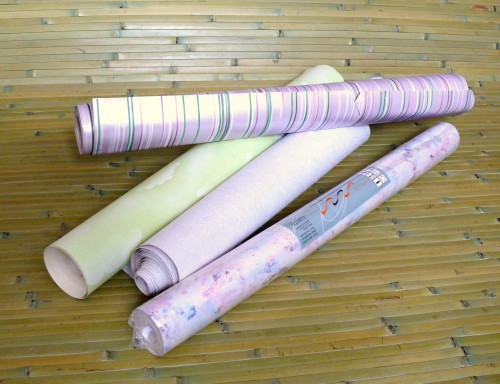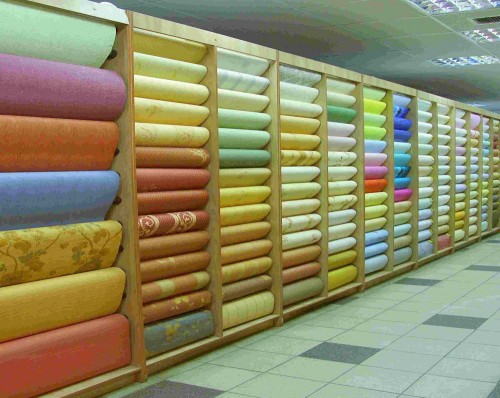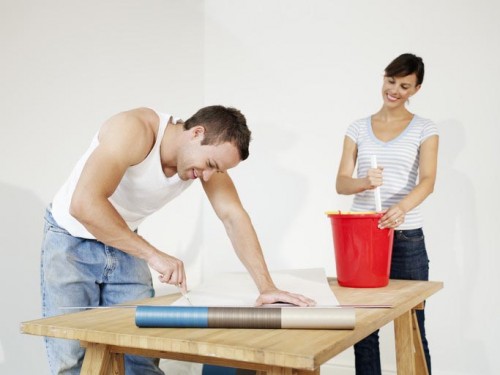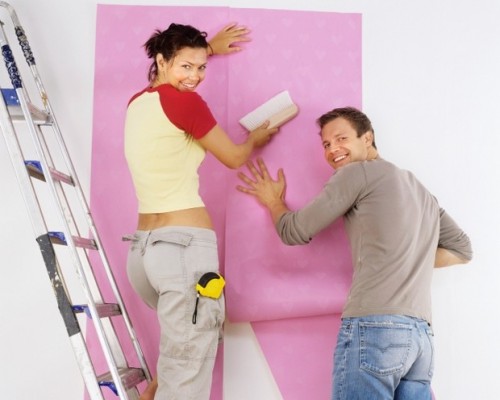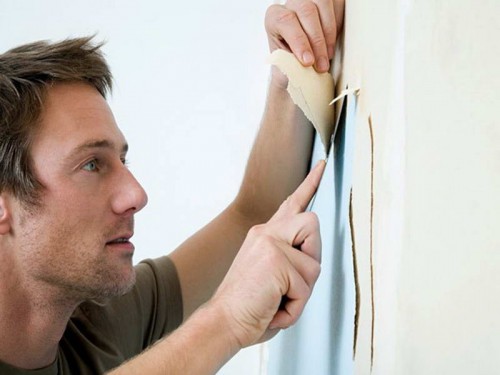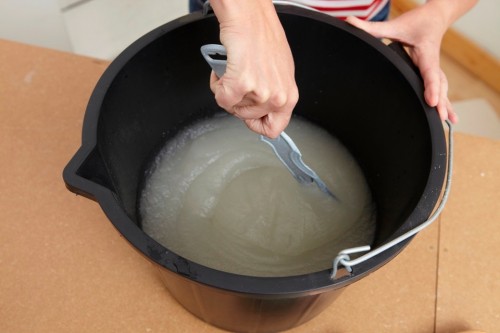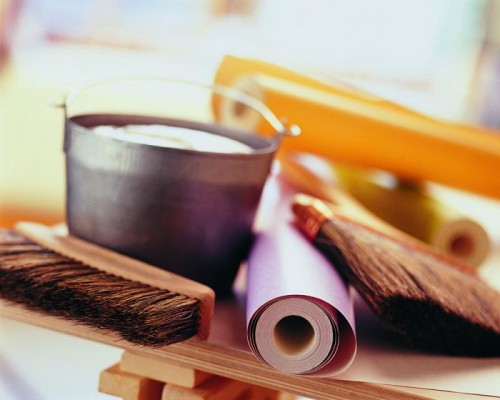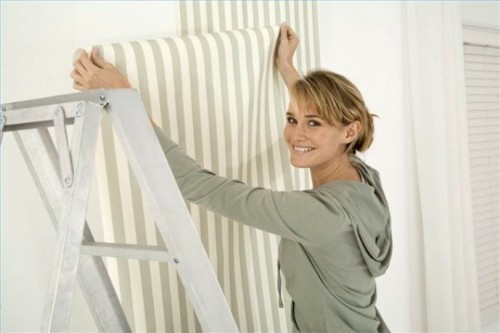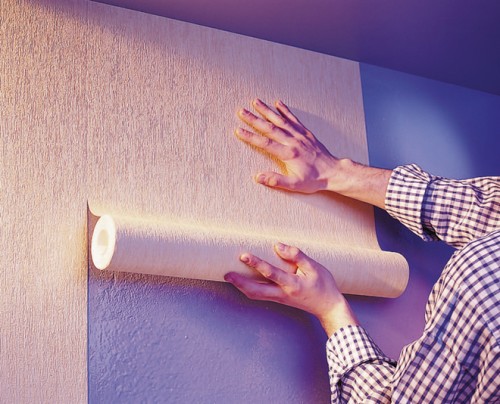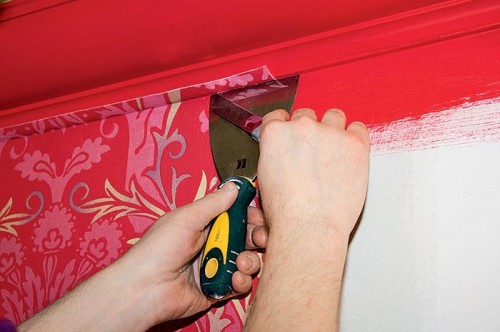If you decide to change the interior in the apartment in a fairly short time and at the same time invest in a modest budget, then you should arm yourself with knowledge how to glue paper wallpapers. This finishing material is distinguished by a wide variety of colors, ease of gluing and low cost. With their help, you can refresh the design solutions every couple of years.
Content
Varieties of paper wallpaper
To date, it is customary to distinguish between two types of paper wallpaper:
- symplex;
- duplex.
Wallpaper Simeplex
Simplex implies a single -layer paper base of wallpaper. This variety is not very in demand in the foreign market, and therefore the commodity assortment is mostly represented by the products of the domestic manufacturer. In turn, symplex wallpapers are divided into:
- smooth;
- relief.
The most popular and less expensive species is so dumped “background” wallpapers. Such material is paper stripes with different colors, printed drawings, etc., which are applied to the front side of the canvas.
In addition, there is an alternative option - a two -layer symplex. Such wallpapers differ in that the paper canvas has two layers with a higher density that do not glue during the manufacture of the canvas.
Wallpaper Duplex
The wallpaper type Duplex is more complicated in production, since the canvas consists of at least two or three layers of paper glued together during the manufacture process. Such paper wallpapers are fashionable to see in many designer catalogs, since they are more popular among consumers.
At the same time, the upper front layer has embossing for a different structure, and the lower layer is smooth. The duplex is characterized by the high strength of the paper layers, as well as a higher heat and soundproofing ability. In addition, such wallpapers are more practical in use, since when gluing they do not distort the drawing and do not get wet from the adhesive composition.
Features of paper wallpaper
Consider the main characteristics of paper wallpaper that determine the feasibility of their use and subtleties when choosing products:
- Like non -woven canvases, paper wallpaper for walls are environmentally friendly products, which is recommended for use in residential premises.
- Traditionally, such products are made to decorate the interior in the children's room, because the assortment is represented by wallpaper in bright colors with funny drawings. The popularity of this category is dictated by the fact that children's wallpapers can often be changed depending on the age of the tenant, and the child can also paint the walls, without fear of spoiling expensive decoration.
- Some collections of paper -type wallpapers are covered with an additional protective layer. Due to this, they can be cleaned with a wet method.
- Thanks to production technologies, paper canvases are completely hypoallergenic.
- The advantage of single -layer products is from unpretentiousness to the adhesive composition and the ability to “breathe”, passing air.
Advantages of paper wallpaper
- ease of use;
- environmental cleanliness of materials;
- relative cheapness;
- high air ductility;
- a wide range of color solutions.
Disadvantages in use
- paper wallpaper requires accurate use;
- low moisture resistance;
- easily subjected to mechanical influences;
- low durability.
Instructions for gluing paper wallpapers
The process of gluing walls with paper wallpaper seems to be a simple task to many, however, there are a number of subtleties in this matter. To avoid common mistakes and unpleasant consequences, you need to carefully know the sequence of actions. Let us consider in more detail each stage.
Preparation of walls for gluing
The first step before starting wallpaper is preparing the surface of the walls. To do this, follow this order of actions:
- Remove cheap paper wallups of the previous repair , softening them with water from the sprayer. For better effectiveness, you can pour soap solution.
- Then arm yourself with a metal spatula to remove fragments of old canvases. If the first time it did not work, spray the wall with liquid again and re -clean the wallpaper.
- If, under the old finishing material, paint is applied on your walls, then before gluing paper wallpapers to polish the enamel with coarse -grained sandpaper. Water -based paint or whitewashing is good to soften under the influence of soap solution. After that, the walls need to be stuck with a spatula until completely cleaned.
- After all the work, you can proceed to eliminate defects, cracks or irregularities on the walls. They need to be thoroughly primed, plastered or put in an even layer putty. Then let the wall dry.
- The final stage in the preparation of the walls before it is properly glued paper wallpaper , the priming of the common surface is. This procedure is performed with a roller or a wide brush, in the direction from the ceiling to the floor. It is important to wait for the complete drying of the walls. Particular attention should be paid to the corners of the room, since wallpaper can be peeled off in them.
Preparation of adhesive composition
Glue for paper wallpaper can be prepared by one person. At the same time, it is important to choose exactly the type of composition that is suitable for this type of material. Glue is popular for lightweight materials, for example, CMC.
Traditionally, kneading the glue looks like this:
- To prepare the composition, pour in a deep container of cold water, about 5-7 liters.
- Then, using any improvised tool, create a whirlpool and slowly pour the dry contents of the pack.
- Stir the liquid thoroughly and leave for swelling, the time of which is clearly defined by the instructions for use.
Important! When gluing a paper type, it is worth remembering the fact that the products are significantly inferior to other types of materials in wear resistance and strength. These characteristics are manifested both during operation and at the time of gluing the canvas. Only one inaccurate movement and the wallpaper can break or shift the pattern. And most importantly - such wallpaper is afraid of water, and therefore they need to glue them as quickly as possible after applying the glue. It is desirable that the room has low humidity. Keep in mind that the glue composition and swelling time should be the same for all lanes.
Preparation of wallpaper material
In order to carefully and carefully glue the wallpaper of the paper type as you need to prepare the following tools:
- roulette;
- wallpaper scissors or knife;
- wet sponge;
- tank for adhesive composition;
- roller or brush for applying glue;
- pencil;
- a segment of dry fabric.
Instructions for the preparation of wallpaper strips look like this:
- In front of the pasting process, paper wallpaper must be cut into canvases. For this, a clerical knife or scissors is used.
- If the prepared material without rapport, i.e. It does not have a fit according to the drawing, then all stripes are made the same length. As a rule, 12-15 cm is left to the general length for trimming.
- If the wallpaper products have a drawing, then it is necessary to select fragments in height so that the images coincide.
- Pay attention to the fact that the wallpaper must be unwound in the same direction from the roll.
- Cut stripes must be folded on each other so that the picture is below. Each prepared stack should not have more than 10 pieces, since they can crush under their weight.
Methodology of wallpaper gluing
Such finishing material is characterized by low strength and speed of wetting. Therefore, it is necessary to observe important subtleties of lean handling of products. Also an important moment is some precautions:
- the apartment must be completely de -energized from the power supply;
- remove all switches and sockets on the walls;
- when gluing the wallpaper, you need to cut out places under the sockets using a stationery knife for this;
- after gluing the wallpaper, put them in place.
Important! It is necessary to make holes under the switches and sockets not in advance, but after the canvas sticks to the wall. When the glue dries, the hole should be cut in the locations. Do not forget to de -energize the electricity before starting work.
The process of gluing is as follows:
- The prepared wallpaper strip must be smeared with adhesive composition from the inside.
- Then fold it four times so that the wrong side is saturated.
- Wait 2 minutes. During this time, it is necessary to treat the wall with glue with a roller. There is no need to miss the entire surface, only the area should be impregnated along the width of the strip, moving from ceiling to floor.
- Then stand on a stepladder, press the strip to the top of the wall and gradually turn the wallpaper.
- As soon as the canvas prefers to the base, smooth the strip with a dry roller or a special rubber spatula, moving from the center to the edges.
- Excess glue that will perform on the sides should be wetted with a soft clean cloth.
- Since paper wallpaper always shrink, they must be glued with a small margin, overlapping. The recommended width of the lining is 0.5 cm. Thus, you will protect yourself from the appearance of the clearance on the walls, which is formed after the wallpaper dries.
- The next canvas must be applied to the wall according to a similar principle.
- After the completion of gluing, let the wallpaper dry for 12-24 hours.
- Hold the sockets and switches to your previous places.
Conclusion
Poving paper wallpaper does not require special professionalism in actions, but negligence in execution will be quite noticeable at the corners and seams of the room. Undoubtedly, everything comes with experience, and therefore having simple skills in working with wallpaper and a brush, plus following the above leadership will help you make impeccable repairs.
Instructions for proper gluing of paper wallpaper are presented in the video:

